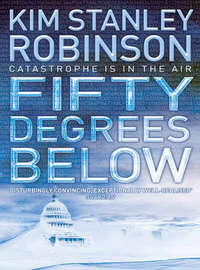
Полная версия
The Martians
So the Martians had come home again, almost as small as the first time around – about two magnitudes bigger than the old ones left behind, that’s right. But the relationship between the little red people and the Archaea was clearly not a simple one. Second cousins thrice removed? Something like that.
Despite this blood tie, the little red people discovered early on in their civilization that their ancestors, the Archaea, could be grown and harvested for food, also for building material, cloth and the like. Inventing this form of agriculture, or husbandry, or industry, allowed for a tremendous population explosion, as the little red people had just taken a step up the food chain, by exploiting the level of life just below theirs. Fine for them, and because they have helped us so much in their subtle way, fine for the humans on Mars as well; but the Archaea considered it barbarous. The little red people interpreted their sullen bovine glares as subservience only, but all the while the Archaea were looking at them thinking, You cannibals, we are going to get you some day.
And so they hatched a plot. They could see that the terraforming was just more of the aerobic same old same old; that the little red people would adapt to it, and become part of the new larger system, and move up onto the surface and take their little red place in the growing biosphere; and meanwhile the old ones would remain trapped in pitch darkness, living off heat and water, and the chemical reactions between hydrogen and carbon dioxide. It isn’t fair, the Archaea said to each other. It won’t do. It was our planet to begin with. We should take it back.
But how? some said. There’s oxygen everywhere you go now, except down here. And they’re making it worse every day.
We’ll find a way, some of the others replied. We are Thermoproteus, we’ll think of something. We’ll infiltrate somehow. They’ve poisoned us; we’ll poison them back. Just bide your time and keep in touch. The anaerobic revolt will have its day.
FOUR THE WAY THE LAND SPOKE TO US
1. THE GREAT ESCARPMENT
You know that the origin of the big dichotomy between the northern lowlands and the southern cratered highlands is still a matter of dispute among areologists. It might be the result of the biggest impact of the early heavy bombardment, and the north therefore the biggest impact basin. Or it may be that tectonic forces were still roiling the early crust, and an early proto-continental craton, like Pangaea on Earth, had risen in the southern hemisphere and then hardened into place, as the smaller planet cooled faster than Earth, without any subsequent tectonic plate break-up and drift. You would think these would be interpretations so diverse that areology would quickly devise questions that would make one or the other explanation either certain or impossible, but so far this is not the case; both explanations have attracted advocates making fully elaborated cases backing their views, and so the matter has shaped itself into one of the primary debates in areology. I myself have no opinion.
The question has ramifications for many other issues in areology, but it’s worth remembering just what the big dichotomy means for people walking across the face of Mars. Hiking across Echus Chasma to its eastern cliffs gives one perhaps the most dramatic approach to the so-called Great Escarpment.
The floor of Echus Chasma is chaos at its most chaotic, and for someone on foot, this means endless divagations and extravagances to make one’s way forward. Nowadays one can follow the trail, and minimize the ups and down, end-runs, dead-ends, and backtracking necessary to make one’s way in any direction; and the Maze Trail is the very model of route-finding efficiency through such torn terrain; nevertheless, if one wanted to get a sense of what it was like in the early days, it is perhaps better to leave the trail, and strike out to forge a new and unrepeatable cross-country ramble through the waste.
If you do that, you will quickly find that your view of your surroundings is inadequate to plan a forward course very far. Often you can see across the land for only a kilometre or less. Big blocks of chunky eroded basalt and andesite are the entirety of the landscape; it’s as if one were crossing a talus whose particulates were two or three magnitudes larger than the talus one usually crushes underfoot. So that one threads through the terrain as an ant must make its way through talus. Small but unclimbable cliffs confront one everywhere one looks. The only way to make progress is to keep to ridgelines, skirting great hole after great hole, while hoping the ridgelines will connect to each other in ways that can be clambered over. It’s like negotiating a hedge maze by staying on the hedge tops.
Chaotic terrain: the name is quite accurate. Here the surface of the world once lost its support, when the aquifer below it drained rapidly away, downhill and over the horizon in a great outflow flood – in this case, down Echus Chasma, round the big bend of Kasei Vallis, down Kasei’s gorge canyon and out onto Chryse Planitia, some two thousand kilometres away. And when that happened the land came crashing down.
So you walk, or climb, or crawl, for day after day, across the tilted surfaces and broken edges of the great blocks of the fallen crust. You can see just what happened: the land dropped; it shattered; there was more of it than there was room for, and so it came to rest all atilt and acrackle. The violence of this ancient collapse has been scarcely masked by the three billion subsequent years of wind erosion and dustfall. It is an irony that such an unstable-looking landscape should actually be so ancient and unchanged.
Then at the peak of one long roofbeam of a ridge, you find yourself high enough that off to the east, a great distance away, just poking over the crackle, lie the tops of a mountain range, pale orange in the late afternoon light. If you camp on this prominence, in the alpenglow the distant range looks like the side of a different world, rolling slowly up into the sky.
But the next morning you descend back into the maze of potholes and passlets, ridgelines and occasional flat block plateaux, like low rooftops in Manhattan. Crossing these terrains commands all your attention, and so you almost forget the sight of the distant mountain range, the problems are so great (it was in this region we found a providential crack in a thirty-metre cliff, which allowed us to climb down safely, lowering our packs on ropes) until at the next prominence in your path through the chaos, it heaves back into view, closer now and seemingly taller, as one can see farther down its side. Not a mountain range, one now sees, but a cliff, extending north and south from horizon to horizon, etched in the usual spur-and-gully formation of cliffs everywhere, and somewhat saw-toothed at its top, but massively solid for all that – the etchings without any depth, like the brushing you see on certain metal surfaces.
And each day, when it stands over your horizon at all, it’s closer. It tends to stay over the horizon longer; but never all the time, as very often you drop into the depths of the next sink in this sunken land. But eventually, continuing roughly eastward, every time you are not actually in the depths of a pothole, the cliff positively looms over the world to the east, towering over the horizon, which stubbornly remains no more than five kilometres away. So at that point you have two horizons, in effect; one near and low, the other far and high.
And eventually you get so close to it that the cliff simply fills the eastern sky. It rises astonishingly near the zenith; it’s like running into the side of a bigger world. Like crawling over a dry cracked sea bed to the side of a continental shelf. The gullies and embayments in the cliff are whole landscapes in themselves now, canyon worlds of great depth and even greater steepness. Every spur between them is now seen to be a huge buttress, ribbing the side of a higher world. The occasional horizontal ledges marking the buttresses appear big enough to support complete island estates. But it’s hard to tell from below.
And indeed, by the time you reach the point called Cliff Bottom View, where you stand on one of the last high points of the chaos, nearly as high as the narrow strip of hilly plateau between the chaos and the escarpment, and you can finally see all the land between where you are and the foot of the great cliff, you can no longer see the cliff’s top. The mass of it blocks your view, and what you see rimming the sky, so far up toward the zenith, is not the true top, though it can seem so if you have not been paying attention, but is rather some prominence part way down its side.
Only by getting into a small blimp and taking off into the air, and flying up and away from the cliff, backing out over the eastern part of the chaos, can you see the whole extent of it. If you keep sight of a reference mark, you can see that what down in the last camp you took for the top of the cliff was only about two-thirds of the way up it; the rest was blocked from view; and in any case the very strong optical effect of foreshortening had deceived you as to the true height of the thing. You keep floating up into the air, up and up and up, like a bird gyring on an updraught, and finally seeing all the cliff at once from this perspective we just started to laugh, we couldn’t help it – we were laughing or crying, or both at once, our mouths were hanging open to our chests, we positively goggled at it, and there was nothing really we could say, it was so big.
2. FLATNESS
There are places out in Argyre that are nothing but flat sand to the horizon in every direction.
Usually the sand is blown into dunes. Any kind of dune, from very fine ripples underfoot to truly gargantuan barchan dunes. But in some areas even that is missing, and it is simply a flat plane of sand or bedrock, with the sky arching over it.
They say that if you look at it closely, the sky forms the visual equivalent of a dome overhead. Not a true hemisphere, but flattened somewhat. This is a virtually universal human perception, the result of consistent over-estimation of horizontal distance compared to vertical distance. On Earth the horizon seems to be two to four times farther off than the zenith overhead, and if you ask someone to divide the arc between the zenith and the horizon evenly, the point chosen averages well less than forty-five degrees; about twenty-two degrees by day, I have found, and thirty by night. Redness increases this effect. If you look at the sky through red glass it appears flatter; if through blue glass, taller.
On Mars the unobstructed horizon is only about half as far away as it is on Earth – about five kilometres – and sometimes this simply makes the zenith seem even lower – perhaps two kilometres high. It depends on the clarity of the air, which of course varies a great deal: sometimes I have seen the dome of the sky appear ten kilometres high, or even transparent to infinity. Mostly lower than that. In fact the vault of the sky is a different shape every day, if you will take the time to look at it carefully.
But no matter the transparency of the sky, or the shape of the dome it makes overhead: the sand is always the same. Flat; reddish brown; redder out toward the horizon. The characteristic redness occurs if even one per cent of the bedrock or the dust on the ground is made up of iron oxides such as magnetite. This condition obtains everywhere on Mars, except for the lava plains of Syrtis, which when blown free of dust are nearly black – one of my favourite places (also the first feature to be seen from Earth through a telescope, by Christiaan Huygens in 1654).
In any case: a perfect red plane in all directions, to the round horizon. Inside certain flat craters, you stand at the centre and see a double horizon, in fact: the lower one five kilometres away, and perfectly straight; the higher one farther away, and usually less straight, even serrated. (This second horizon also considerably flattens the dome of the sky.)
But the completely flat areas are the purest view. Much of Vastitas Borealis is so flat that only millions of years of existence as the floor of an ocean can explain it. And parts of Argyre Planitia are equally flat. We cannot lose these places. In these regions one stands confronted by a radically simplified landscape. It is a surreal experience to look around oneself – surreal in the literal sense of the word, in that one seems to stand in a place ‘over-real’, or ‘more than real’ – a higher state than reality; or reality revealed in its barest, most heraldic simplicity. The world says then, This is what the cosmos consists of: rock, sky, sun, life (that’s you). What a massive aesthetic impact is conveyed by this so-simplified landscape! It forces you to pay attention to it; it is so remarkable you keep looking at it, you cannot do or think anything else – as if living in a perpetual total eclipse, or within any other physical miracle. Which of course is always the case. Remember.
FIVE MAYA AND DESMOND
1. FINDING HIM
After she saw the strange face through the bottle in the farm of the Ares, Maya couldn’t stop thinking of it. It frightened her, but she was no coward. And that had been a stranger, not one of the hundred. There on her ship.
And then she told John about it, and he believed her. He believed in her; and so she was going to have to track that stranger down.
She began by calling up the plans for the ship and studying them as she had never studied them before. It surprised her to find how many spaces it contained, how large their total volume. She had known the areas the way one knows a hotel or a ship or a plane, or one’s home town for that matter – as a set of her life-routes, wound through the whole in an internal mental map, which itself could be called up sharply visible in her mind’s eye; but the rest was only vagueness, deduced, if she ever thought about it, from the parts she knew; but deduced wrongly, as she now found out.
Still, there was only so much liveable space in the thing. The axis cylinders were not liveable, by and large, and the eight toruses were, for the most part; but they were also very heavily travelled. Hiding would not be easy.
She had seen him in the farm. It seemed possible, even perhaps likely, that the man had allies in the farm crew, helping him to hide. A lone stowaway, unknown to anyone aboard, was difficult for her to believe in.
So she began in the farm.
Each torus was octagonal, made of eight American shuttle fuel canisters that had been boosted into orbit and then coupled together. More bundled canisters formed the long axis that speared down the centres of the torus octagons, and the octagons were connected to the central axis by narrow spokelike passage tubes. The entire spacecraft spun on the long axis as it moved forward toward Mars, spinning at a speed which created a centrifugal force the equivalent of Martian gravity, at least for people walking on the floors set against the outside of the torus rings. The Coriolis force meant that if you walked against the rotation of the ship you felt as if you were leaning forwards a little. The opposite effect, walking in the other direction, was somehow not so noticeable. You had to lean into reality to make progress.
The farm chamber filled torus F, the well-lit rows of vegetables and cereals lined out in a circular infinity. Above the ceilings and under the floors the supplies were kept. A lot of spaces to hide, in other words, when you got right down to searching for someone. Especially if you were trying to search in secret, which Maya most definitely was. She did it at night, after people were asleep. Here they were in space and yet people were still incredibly diurnal, regular as clockwork; indeed only clockwork kept them to it, but it was the clockwork of their own biology; and indicative of just how much of their animal natures they were carrying with them. But it gave Maya her opportunity.
She started in the chamber where she had seen the face, and made sure that no one ever saw her at work. So already she was a kind of ally of the man. She worked her way forward through the farm, row by row, storage compartment by storage compartment, tank by tank. No one there. She moved down the ship one torus to the storage tanks, and did the same. Days were passing, and Mars was the size of a coin ahead of them.
As her search progressed she realized how much all the chambers looked the same, no matter how they had been customized for use. They were living inside tanks of metal, and each tank resembled the others, much like the years of a life. Much like city life everywhere, she saw one day: room after room after room. Occasionally the great bubble chamber that was the sky. Human life, a matter of boxes. The escape from freedom.
She searched all the toruses and didn’t find him. She searched the axis tanks and didn’t find him.
He could have been in someone’s room, many of which were locked, as in any hotel. He could be in a place she hadn’t looked. He could be aware of her, and moving away from her as she searched.
She began again.
Time was running out. Mars was the size of an orange. A bruised and mottled orange. Soon they would arrive and go through aerobraking and orbit calming.
It was almost as if she were being watched. She had always felt observed somehow, as if she were living her life on an invisible stage, performing it for an invisible audience who followed her story with interest, and judged her. There had to be something that heard her endless train of thoughts, didn’t there?
But this was more physical than that. She went through the crowded days prepping for arrival, slipping off to make love with John, fencing with Frank to avoid doing the same with him, and all the while feeling there was an eye on her, somewhere. She had learned that no matter where she was, she was in a tank filled with objects, and had trained herself to see the things filling the tank against the Platonic form of the tank itself, looking for discrepancies like false walls or floors, and finding some. Jumping around occasionally. But never catching that eye.
One night she came out of John’s room and felt she was alone. Immediately she returned to the farm, and went from its ceiling up to the axis tanks. Above the ceiling, under the low curve of the inner tank wall, was a storage chamber with a back wall that was too close to be the true end of the tank. She had seen that while eating breakfast one morning, without thinking about anything at all. Now she pulled away a stack of boxes set against this false wall, and saw the whole wall was a door, with a handle.
It was locked.
She leaned back, thought about it. She rapped lightly on the door, three times.
‘Roko?’ said a hoarse voice from within.
Maya said nothing. Her heart was beating hard and fast. The handle turned and she snatched it and yanked the door open, pulling out a thin brown arm. She let go of the door and grabbed the arm harder than the door; instantly she was yanked back into the tiny closet, and seized by hands with a talon grip.
‘Stop it!’ she cried, and as the man was trying to flee under her arm, she crashed down onto him, hitting boxes and insulation padding hard, but staying latched to a wrist. She sat on him with all her force, as if pinning an enraged child. ‘Stop it! I know you’re here.’
He gave up trying to escape.
They both shifted to get more comfortable, and she lessened her grip on the man’s arm, but still held on, not trusting him not to bolt. A small wiry black man, thin face bent or asymmetrical somehow, big brown eyes as frightened as a deer’s. Thin wrist, but forearm muscles like rocks under the skin. He was quivering in her grip. Years later when she remembered this first meeting, what she remembered was his flesh trembling in her grip, trembling like a frightened fawn.
Fiercely she said, ‘What do you think I’m going to do? Do you think I’m going to tell everyone about you? Or send you home? Do you think I’m that kind of person?’
He shook his head, face averted, but glancing at her with a new surmise.
‘No,’ he said, in almost a whisper. ‘I know you’re not. But I been so afraid.’
‘Not necessary with me,’ she said. Impulsively she reached out with her free hand and touched the side of his head. He shivered like a horse. Body like a bantamweight wrestler. An animal, moving involuntarily at the touch of another animal. Starved for touch, perhaps. She moved back away from him, let go of his arm, sat with her back leaning against the padding on the wall, watching him. An odd face somehow, narrow and triangular, with that asymmetry. Like pictures in magazines of Rastafarians from Jamaica. From below wafted the smell of the farm. He had no smell as far as she could tell, or else just more of the farm.
‘So who’s helping you?’ she said. ‘Hiroko?’
His eyebrows shot up. After a moment’s hesitation: ‘Yeah. Of course. Hiroko Ai, God damn her. My boss.’
‘Your mistress.’
‘My owner.’
‘Your lover.’
Disconcerted, he looked down at his hands, bigger than his body seemed to need. ‘Me and half the farm team,’ he said with a bitter little smile. ‘All of us wrapped around her little finger. And me living in a crawl space, for Christ’s sake.’
‘To get to Mars.’
‘To get to Mars,’ he repeated bitterly. ‘To be with her, you mean. Crazy man that I am, damn fool idiot crazy man.’
‘Where are you from?’
‘Tobago. Trinidad Tobago, do you know it?’
‘Caribbean? I visited Barbados once.’
‘Like that, yeah.’
‘But now Mars.’
‘Some day.’
‘We’re almost there,’ she said. ‘I was afraid we would get there before I found you.’
‘Hmph,’ he said, looking up at her briefly, thinking this over. ‘Well. Now I not in such a hurry to get there.’ He looked up again, with a shy smile.
She laughed.
She asked him more questions, and he replied, and asked more of his own. He was funny – like John in that – only sharper-edged than John. A bitterness there; and interesting, she suddenly realized, just as someone new, someone she didn’t already know all too well. You got to watch out for Hiroko, he warned her at one point. ‘Hiroko, Phyllis, Arkady – they be trouble. Them and Frank, of course.’
‘Tell me about it.’
‘It’s quite a crew you have,’ he replied slyly, observing her.
‘Yes.’ She rolled her eyes: what could one say?
He grinned. ‘You won’t tell them about me?’
‘No.’
‘Thanks.’ Now it was him holding her by the wrist. ‘I’ll help you, I swear. I’ll be your friend.’ Staring her right in the eye, for the first time.
‘And I’ll be yours,’ she said, feeling touched, then suddenly happy. ‘I’ll help you too.’
‘We’ll help each other. There’ll be the hundred and all their jostle, and then you and me, helping each other.’
She nodded, liking the idea. ‘Friends.’
She freed her arm, and with a brief squeeze of his shoulder got up to leave. He still trembled slightly under her hand.
‘Wait – what’s your name?’
‘Desmond.’
2. HELPING HIM
Thus in Underhill Maya always knew her stowaway Desmond was out there in the farm, getting by in circumstances almost as prisonlike as those he had suffered on the Ares. For days and months at a time she forgot this as she mangled her relationships with John and Frank, irritating Nadia and Michel, who were both nearly worthless to her, and irritating herself just as often or more – feeling incompetent and depressed, she didn’t know why – having difficulty adjusting to life on Mars, no doubt. It was miserable in a lot of ways, to be cooped up in the trailers and then the quadrangle, with only each other. It wasn’t that much different from the Ares, to tell the truth.









